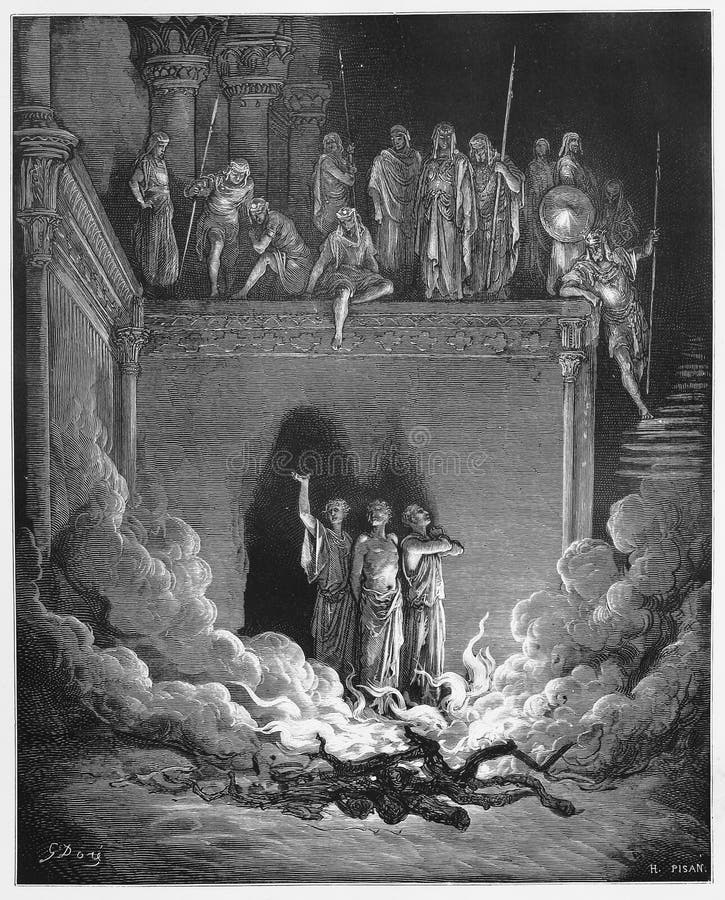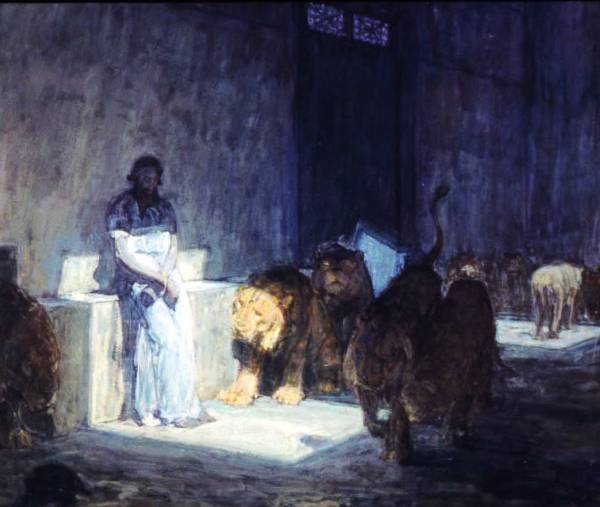
“Shadrach, Meshach and Abednego in the Burning Fiery Furnace…”
* * * *
Friday, April 17, 2015 – The last time I reviewed a Daily Office Reading was on Friday, March 13. That post was Jeremiah weeping and Jesus’ “stoning.” It included this:
The last time I did background and color commentary on Daily Office Readings (DORs) was on February 20. That post was The True Test of Faith. It talked about how two different Christians might react if they died, and only then found out that there was no God, no afterlife and no “reward for being good.”
This post is a variation on that theme. The theme here is: “What is a true test of faith?” In this post the true test of faith was the threat of getting thrown into a “burning fiery furnace,” while not knowing – or even caring – if God would do anything to stop it…
Starting Monday, April 12, the Old Testament Readings (OTRs) were from the Book of Daniel. (See Daniel 1:1-21.) Daniel is best known for getting thrown into a lion’s den, but his book includes lots of other good stuff, including an early apocalypse. (A better known apocalypse is the Book of Revelation, the last book of the Bible.)
The Old Testament readings from Daniel – for today and tomorrow, April 17 and 18 – tell the story of Shadrach, Meshach, and Abednego. (See also Daniel 3:1-18, and 3:19-30.)
Here’s what happened. In 606 B.C., King Nebuchadnezzar of Babylon conquered Judea and its capital Jerusalem. Then came the first of many Jewish mass deportations, and especially of:
…young men without physical defect and handsome, versed in every branch of wisdom, endowed with knowledge and insight, and competent to serve in the king’s palace; they were to be taught the literature and language of the Chaldeans.
 Daniel 1:4. See also Babylonian captivity (or exile) – Wikipedia.
Daniel 1:4. See also Babylonian captivity (or exile) – Wikipedia.
That is, the Babylonian Army conquered the “ancient Kingdom of Judah,” and among other things forced a number of highly-educated, upper-class Hebrews into exile. They were then forced to serve the king in his capital city of Babylon, some 53 miles south of present-day Baghdad.
(Note also “Babylonian” and “Chaldean” are interchangeable, and refer to a tribe of nomads who first lived in now-southern-Iraq. The map shows the Babylonian Empire at its greatest extent.)
In further words, it was the hoity-toity, the well-educated and/or upper-class Hebrews who got taken away to live in exile in Babylon. (An exile that many of them found quite surprisingly pleasant.) In still further words, the riffraff got left back at home.
So anyway, getting back to the story… Daniel and his three friends were among the “handsome young men” who got deported to Babylon and taught the literature and language of the Chaldeans. The three friends were originally named Hananiah, Mishael and Azariah, but by royal decree their original Hebrew names were changed, to Shadrach, Meshach and Abednego.
(Daniel’s name was changed to Belteshazzar, about which more later.)
And the king gave three men prominent positions within his administration. (They were made “administrators over the province of Babylon.” Daniel 2:49.) But there’s always a catch…
In this case the catch was that King Nebuchadnezzer had a giant golden statue of himself built. Then he ordered that all his subjects bow down and worship it – him – whenever they heard “the sound of the horn, pipe, lyre, trigon, harp, drum, and entire musical ensemble.” Daniel 3:5,7.
The king further ordered that “whoever does not fall down and worship shall immediately be thrown into a furnace of blazing fire.” Daniel 3:6. And so – to make a long story short – Shadrach, Meshach and Abednego refused to fall down and worship a foreign “god,” and especially because Nebuchadnezzar was a mere man himself.
As a result they got thrown into the burning fiery furnace, just as the king had threatened. But the real kicker in the story comes at Daniel 3:16-18. There the three men – about to be thrown into the burning, fiery furnace – gave their answer to King Nebuchadnezzer:
Shadrach, Meshach, and Abednego answered the king, “O Nebuchadnezzar, we have no need to present a defence to you in this matter. If our God whom we serve is able to deliver us, he will deliver us from the furnace of blazing fire and out of your hand, O king. But if not, be it known to you, O king, that we will not serve your gods and we will not worship the golden statue that you have set up.”
Note the emphasized “But if not…” So what the three men were really saying was something like this: “O Nebuchadnezzar, it’s up to God Himself to decide if He’ll deliver us out of your hands from this dreadful, painful and agonizing death. God certainly has the power to save us, but even if He decides not to, we will still believe in and follow Him…”
* * * *
Now that is a true test(ament) of faith…
* * * *

Another guy who gave a “true test(ament) of faith…”
* * * *
The upper image is courtesy of Shadrach Meshach And Abednego Mallord Turner Image – Image Results. The image itself is from the books collection published in 1885, Stuttgart-Germany. Drawings by Gustave Dore. See also Shadrach, Meshach and Abednego in the Burning Fiery Furnace, and the Tate Gallery, or “Tate Britain, Millbank, London SW1P 4RG, United Kingdom.” The Tate Gallery (London) is – by its own admission – the “home of British art from 1500 to the present day.” The full caption of that painting: “Joseph Mallord William Turner[‘s painting:] Shadrach, Meshach and Abednego in the Burning Fiery Furnace exhibited 1832:”
Turner exhibited this picture in 1832, with a passage from the Bible (Daniel iii, 26). This told how Shadrach, Meshach and Abednego emerged unharmed from the fiery furnace they had been thrown into for refusing to worship Nebuchadnezzar’s idol (visible in the distance).
In turn, “J. M. W. Turner” (1775-1851) – who did the painting – was an “English Romanticist landscape painter, water-colourist, and printmaker.” Some contemporaries thought him too controversial, but he’s come to be regarded as “the artist who elevated landscape painting to an eminence rivalling history painting.” His oil paintings were good, but “Turner is also one of the greatest masters of British watercolour landscape painting.” He was known as “the painter of light,” and his paintings – oil and watercolor – are seen as a “Romantic preface to Impressionism.” See Wikipedia.
The lower image is courtesy of Daniel and the Lions Den – Hebrew Bible and Art. The painting itself is by Henry Ossawa Tanner (1859-1937), “the first African-American painter to gain international acclaim. He moved to Paris in 1891 to study, and decided to stay there, being readily accepted in French artistic circles. His painting entitled Daniel in the Lions’ Den was accepted into the 1896 Salon.” The painting itself “uses light to symbolize [G]od’s presence. It is simple and there is not a lot of detail but it gets the point across.” See also Wikipedia, the free encyclopedia.
Re: “et al.” The term is “short for et alia, a Latin phrase meaning and the others,” or in the alternative, “and others.” The term is often used in the title of legal cases, as in: IN THE MATTER OF VITO J. SETTINERI, ET AL., RESPONDENTS, v. ROBERT J. DICARLO, ET AL., APPELLANTS.
Re: Chaldeans. They were “an intelligent and sometimes aggressive, warlike people,” who generally lived in “southern Babylonia which would be the southern part of Iraq today:”
Sometimes the term Chaldeans is used to refer to Babylonians in general, but normally it refers to a specific semi-nomadic tribe that lived in the southern part of Babylon. The land of the Chaldeans was the southern portion of Babylon or Mesopotamia. It was generally thought to be an area about 400 miles long and 100 miles wide alongside of the Tigris and Euphrates Rivers.
It turned out that in the fullness of time, Babylon ended up being ruled by a string of such Chaldeans, while other tribesmen became members of the ruling elite. As in, those Chaldeans who “influenced Nebuchadnezzar’s decision to throw Shadrach, Meshach, and Abednego into the fiery furnace (Daniel 3:8).” See Who were the Chaldeans in the Bible? – GotQuestions.org.
Re: the capital city of Babylon. See Babylon – Wikipedia, the free encyclopedia: “The remains of the city are in present-day Hillah … Iraq, about 85 kilometres (53 mi) south of Baghdad, comprising a large tell of broken mud-brick buildings and debris.”
Re: Daniel 3:17. An alternate translation: “If our God whom we serve is able to deliver us from the furnace of blazing fire and out of your hand, O king, let him deliver us.” For more on this subject see: What should we learn from the account of Shadrach, Meshach, and Abednego, Shadrach, Meshach, And Abednego – Bible Story Summary, and/or The Burning Fiery Furnace – Wikipedia.
The first article, What should we learn, had this to say:
God does not always guarantee that we will never suffer or experience death, but He does promise to be with us always. We should learn that in times of trial and persecution our attitude should reflect that of these three young men: “But even if he does not…” (Daniel 3:18). Without question, these are some of the most courageous words ever spoken.
And incidentally, the fire was so hot that the soldiers assigned to throw the three men into the fire got burnt to a crisp. See Daniel 3:22. (Which surely presents some kind of object lesson…)